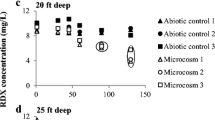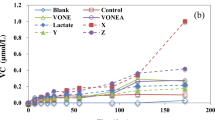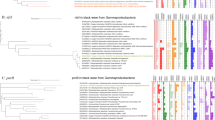Abstract
Post-treatment impacts of a novel combined hydrogen peroxide (H2O2) oxidation and WOx/ZrO2 catalysis used for the removal of 1,4-dioxane and chlorinated volatile organic compound (CVOC) contaminants were investigated in soil and groundwater microbial community. This treatment train removed ~90% 1,4-dioxane regardless of initial concentrations of 1,4-dioxane and CVOCs. The Illumina Miseq platform and bioinformatics were used to study the changes to microbial community structure. This approach determined that dynamic shifts of microbiomes were associated with conditions specific to treatments as well as 1,4-dioxane and CVOCs mixtures. The biodiversity was observed to decrease only after oxidation under conditions that included high levels of 1,4-dioxane and CVOCs, but increased when 1,4-dioxane was present without CVOCs. WOx/ZrO2 catalysis reduced biodiversity across all conditions. Taxonomic classification demonstrated oxidative tolerance for members of the genera Massilia and Rhodococcus, while catalyst tolerance was observed for members of the genera Sphingomonas and Devosia. Linear discriminant analysis effect size was a useful statistical tool to highlight representative microbes, while the multidimensional analysis elucidated the separation of microbiomes under the low 1,4-dioxane-only condition from all other conditions containing CVOCs, as well as the differences of microbial population among original, post-oxidation, and post-catalysis states. The results of this study enhance our understanding of microbial community responses to a promising chemical treatment train, and the metagenomic analysis will help practitioners predict the microbial community status during the post-treatment period, which may have consequences for long-term management strategies that include additional biodegradation treatment or natural attenuation.

Similar content being viewed by others
References
Adamson D, Newell C, Mahendra S, Bryant D, Wong M (2017). In situ treatment and management strategies for 1, 4-dioxane-contaminated groundwater. Houston: GSI Environmental Inc., Houston United States. SERDP Project ER-2307
Adamson D T, Anderson R H, Mahendra S, Newell C J (2015). Evidence of 1,4-dioxane attenuation at groundwater sites contaminated with chlorinated solvents and 1,4-dioxane. Environmental Science & Technology, 49(11): 6510–6518
Anderson R H, Anderson J K, Bower P A (2012). Co-occurrence of 1,4-dioxane with trichloroethylene in chlorinated solvent groundwater plumes at US Air Force installations: Fact or fiction. Integrated Environmental Assessment and Management, 8(4): 731–737
Barndõk H, Hermosilla D, Han C, Dionysiou D D, Negro C, Blanco A (2016). Degradation of 1,4-dioxane from industrial wastewater by solar photocatalysis using immobilized NF-TiO2 composite with monodisperse TiO2 nanoparticles. Applied Catalysis B: Environmental, 180: 44–52
Bidaud P, Hébert L, Barbey C, Appourchaux A C, Torelli R, Sanguinetti M, Laugier C, Petry S (2012). Rhodococcus equi’s extreme resistance to hydrogen peroxide is mainly conferred by one of its four catalase genes. PLoS One, 7(8): e42396
Chao Y, Liu W, Chen Y, Chen W, Zhao L, Ding Q, Wang S, Tang Y T, Zhang T, Qiu R L (2016). Structure, variation, and co-occurrence of soil microbial communities in abandoned sites of a rare earth elements mine. Environmental Science & Technology, 50(21): 11481–11490
Chen K F, Chang Y C, Chiou W T (2016). Remediation of dieselcontaminated soil using In situ chemical oxidation (ISCO) and the effects of common oxidants on the indigenous microbial community: a comparison study. Journal of Chemical Technology and Biotechnology (Oxford, Oxfordshire), 91(6): 1877–1888
Chitra S, Paramasivan K, Cheralathan M, Sinha P K (2012). Degradation of 1,4-dioxane using advanced oxidation processes. Environmental Science and Pollution Research International, 19(3): 871–878
Choi P G, Nunotani N, Imanaka N (2017). High catalytic efficiency in liquid-phase oxidation of 1,4-dioxane using a Pt/CeO2-ZrO2-SnO2/SBA-16 catalyst. International Journal of Applied Ceramic Technology, 14(1): 9–15
Dingman D W (2011). Inactivation of Paenibacillus larvae endospores by a hydrogen peroxide/peroxyacetic acid biocide. Journal of Apicultural Research, 50(2): 173–175
Eberle D, Ball R, Boving T B (2016). Peroxone activated persulfate treatment of 1,4-dioxane in the presence of chlorinated solvent cocontaminants. Chemosphere, 144: 728–735
Feng Y, Lee P H, Wu D, Shih K (2017). Surface-bound sulfate radicaldominated degradation of 1,4-dioxane by alumina-supported palladium (Pd/Al2O3) catalyzed peroxymonosulfate. Water Research, 120: 12–21
Fida T T, Moreno-Forero S K, Breugelmans P, Heipieper H J, Röling W F, Springael D (2017). Physiological and transcriptome response of the polycyclic aromatic hydrocarbon degrading Novosphingobium sp. LH128 after Inoculation in soil. Environmental Science & Technology, 51(3): 1570–1579
Gedalanga P, Madison A, Miao Y, Richards T, Hatton J, DiGuiseppi W H, Wilson J, Mahendra S (2016). A multiple lines of evidence framework to evaluate intrinsic biodegradation of 1,4-dioxane. Remediation, 27(1): 93–114
Gedalanga P B, Pornwongthong P, Mora R, Chiang S Y D, Baldwin B, Ogles D, Mahendra S (2014). Identification of biomarker genes to predict biodegradation of 1,4-dioxane. Applied and Environmental Microbiology, 80(10): 3209–3218
Gururani M A, Upadhyaya C P, Baskar V, Venkatesh J, Nookaraju A, Park S W (2013). Plant growth-promoting Rhizobacteria enhance abiotic stress tolerance in Solanum tuberosum through inducing changes in the expression of ROS-scavenging enzymes and improved photosynthetic performance. Journal of Plant Growth Regulation, 32(2): 245–258
Hall E A, Bell S G (2015). The efficient and selective biocatalytic oxidation of norisoprenoid and aromatic substrates by CYP101B1 from Novosphingobium aromaticivorans DSM12444. RSC Advances, 5(8): 5762–5773
Handtke S, Schroeter R, Jürgen B, Methling K, Schlüter R, Albrecht D, van Hijum S A F T, Bongaerts J, Maurer K H, Lalk M, Schweder T, Hecker M, Voigt B (2014). Bacillus pumilus reveals a remarkably high resistance to hydrogen peroxide provoked oxidative stress. PLoS One, 9(1): e85625
Ikehata K, Wang-Staley L, Qu X Y, Li Y (2016). Treatment of groundwater contaminated with 1,4-dioxane, tetrahydrofuran, and chlorinated volatile organic compounds using advanced oxidation processes. Ozone Science and Engineering, 38(6): 413–424
Inoue D, Tsunoda T, Sawada K, Yamamoto N, Saito Y, Sei K, Ike M (2016). 1,4-Dioxane degradation potential of members of the genera Pseudonocardia and Rhodococcus. Biodegradation, 27(4-6): 277–286
Jasmann J R, Gedalanga P B, Borch T, Mahendra S, Blotevogel J (2017). Synergistic treatment of mixed 1,4-dioxane and chlorinated solvent contaminations by coupling electrochemical oxidation with aerobic biodegradation. Environmental Science & Technology, 51(21): 12619–12629
Klindworth A, Pruesse E, Schweer T, Peplies J, Quast C, Horn M, Glöckner F O (2013). Evaluation of general 16S ribosomal RNA gene PCR primers for classical and next-generation sequencingbased diversity studies. Nucleic Acids Research, 41(1): e1
Lan R S, Smith C A, Hyman M R (2013). Oxidation of cyclic ethers by alkane-grown Mycobacterium vaccae JOB5. Remediation Journal, 23(4): 23–42
Laurent F, Cébron A, Schwartz C, Leyval C (2012). Oxidation of a PAH polluted soil using modified Fenton reaction in unsaturated condition affects biological and physico-chemical properties. Chemosphere, 86 (6): 659–664
Lefevre E, Bossa N, Wiesner M R, Gunsch C K (2016). A review of the environmental implications of In situ remediation by nanoscale zero valent iron (nZVI): Behavior, transport and impacts on microbial communities. Science of The Total Environment, 565: 889–901
Li J, Lu Q, de Toledo R A, Lu Y, Shim H (2015b). Effect of toluene concentration and hydrogen peroxide on Pseudomonas plecoglossicida cometabolizing mixture of cis-DCE and TCE in soil slurry. Environmental Geochemistry and Health, 37(6): 985–995
Li M, Fiorenza S, Chatham J R, Mahendra S, Alvarez P J J (2010). 1,4-Dioxane biodegradation at low temperatures in Arctic groundwater samples. Water Research, 44(9): 2894–2900
Li M, Van Orden E T, DeVries D J, **ong Z, Hinchee R, Alvarez P J (2015a). Bench-scale biodegradation tests to assess natural attenuation potential of 1,4-dioxane at three sites in California. Biodegradation, 26(1): 39–50
Mahendra S, Alvarez-Cohen L (2005). Pseudonocardia dioxanivorans sp. nov., a novel actinomycete that grows on 1,4-dioxane. International Journal of Systematic and Evolutionary Microbiology, 55(2): 593–598
Mahendra S, Alvarez-Cohen L (2006). Kinetics of 1,4-dioxane biodegradation by monooxygenase-expressing bacteria. Environmental Science & Technology, 40(17): 5435–5442
Mahendra S, Grostern A, Alvarez-Cohen L (2013). The impact of chlorinated solvent co-contaminants on the biodegradation kinetics of 1,4-dioxane. Chemosphere, 91(1): 88–92
Mahendra S, Petzold C J, Baidoo E E, Keasling J D, Alvarez-Cohen L (2007). Identification of the intermediates of in vivo oxidation of 1, 4- dioxane by monooxygenase-containing bacteria. Environmental Science & Technology, 41(21): 7330–7336
McMurdie P J, Holmes S (2013). phyloseq: an R package for reproducible interactive analysis and graphics of microbiome census data. PLoS One, 8(4): e61217
Medina R, David Gara P M, Fernández-González A J, Rosso J A, Del Panno M T (2018). Remediation of a soil chronically contaminated with hydrocarbons through persulfate oxidation and bioremediation. Science of The Total Environment, 618: 518–530
Miao Y, Liao R, Zhang X X, Wang Y, Wang Z, Shi P, Liu B, Li A (2015). Metagenomic insights into Cr(VI) effect on microbial communities and functional genes of an expanded granular sludge bed reactor treating high-nitrate wastewater. Water Research, 76: 43–52
Miao Y, Wang Z, Liao R H, Shi P, Li A M (2017). Assessment of phenol effect on microbial community structure and function in an anaerobic denitrifying process treating high concentration nitrate wastewater. Chemical Engineering Journal, 330: 757–763
Mohr T K G, Stickney J A, DiGuiseppi W H (2010). Environmental Investigation and Remediation: 1,4-Dioxane and Other Solvent Stabilizers. Boca Raton, FL: CRC Press, Taylor & Francis Group
Munakata-Marr J, Sorenson K S, Petri B G, Cummings J B (2011). Principles of combining ISCO with other in situ remedial approaches. In: Siegrist R, Crimi M, Simpkin T, eds. In situ Chemical Oxidation for Groundwater Remediation. New York, NY: Springer, SERDP/ESTCP Environmental Remediation Technology, vol 3, 285–317
Myers M A, Johnson NW, Zerecero-Marin E, Pornwongthong P, Liu Y, Gedalanga P B, Mahendra S (2018). Abiotic and bioaugmented granular activated carbon for the treatment of 1,4-dioxane-contaminated water. Environmental Pollution, 240: 916–924
Nemecek J, Pokorný P, Lhotský O, Knytl V, Najmanová P, Steinová J, Cerník M, Filipová A, Filip J, Cajthaml T (2016). Combined nanobiotechnology for in-situ remediation of mixed contamination of groundwater by hexavalent chromium and chlorinated solvents. Science of The Total Environment, 563–564: 822–834
Padhy R N, Nayak N, Rath S (2014). Antagonism at combined effects of chemical fertilizers and carbamate insecticides on the rice-field N2- fixing cyanobacterium Cylindrospermum sp. in vitro. Interdisciplinary Toxicology, 7(1): 5–11
Pornwongthong P, Mulchandani A, Gedalanga P B, Mahendra S (2014). Transition metals and organic ligands influence biodegradation of 1,4-dioxane. Applied Biochemistry and Biotechnology, 173(1): 291–306
Richardson S D, Lebron B L, Miller C T, Aitken M D (2011). Recovery of phenanthrene-degrading bacteria after simulated in situ persulfate oxidation in contaminated soil. Environmental Science & Technology, 45(2): 719–725
San Miguel A, Roy J, Gury J, Monier A, Coissac E, Ravanel P, Geremia R A, Raveton M (2014). Effects of organochlorines on microbial diversity and community structure in Phragmites australis rhizosphere. Applied Microbiology and Biotechnology, 98(9): 4257–4266
Santiago A J, Ahmed M N A, Wang S L, Damera K, Wang B, Tai P C, Gilbert E S, Derby C D (2016). Inhibition and dispersal of Pseudomonas aeruginosa biofilms by combination treatment with escapin intermediate products and hydrogen peroxide. Antimicrobial Agents and Chemotherapy, 60(9): 5554–5562
Schloss P D, Westcott S L, Ryabin T, Hall J R, Hartmann M, Hollister E B, Lesniewski R A, Oakley B B, Parks D H, Robinson C J, Sahl JW, Stres B, Thallinger G G, Van Horn D J, Weber C F (2009). Introducing mothur: open-source, platform-independent, community-supported software for describing and comparing microbial communities. Applied and Environmental Microbiology, 75(23): 7537–7541
Segata N, Izard J, Waldron L, Gevers D, Miropolsky L, Garrett W S, Huttenhower C (2011). Metagenomic biomarker discovery and explanation. Genome Biology, 12(6): R60
Sei K, Kakinoki T, Inoue D, Soda S, Fujita M, Ike M (2010). Evaluation of the biodegradation potential of 1,4-dioxane in river, soil and activated sludge samples. Biodegradation, 21(4): 585–591
Sekar R, Taillefert M, DiChristina T J (2016). Simultaneous transformation of commingled trichloroethylene, tetrachloroethylene, and 1,4-dioxane by a microbially driven fenton reaction in batch liquid cultures. Applied and Environmental Microbiology, 82(21): 6335–6343
Simonin M, Richaume A (2015). Impact of engineered nanoparticles on the activity, abundance, and diversity of soil microbial communities: a review. Environmental Science and Pollution Research International, 22(18): 13710–13723
Soultanidis N, Zhou W, Psarras A C, Gonzalez A J, Iliopoulou E F, Kiely C J, Wachs I E, Wong M S (2010). Relating n-pentane isomerization activity to the tungsten surface density of WO(x)/ZrO2. Journal of the American Chemical Society, 132(38): 13462–13471
Suthersan S, Quinnan J, Horst J, Ross I, Kalve E, Bell C, Pancras T (2016). Making strides in the management of “Emerging Contaminants”. Ground Water Monitoring and Remediation, 36(1): 15–25
Sutton N B, Langenhoff A A, Lasso D H, van der Zaan B, van Gaans P, Maphosa F, Smidt H, Grotenhuis T, Rijnaarts H H (2014). Recovery of microbial diversity and activity during bioremediation following chemical oxidation of diesel contaminated soils. Applied Microbiology and Biotechnology, 98(6): 2751–2764
Vainberg S, McClay K, Masuda H, Root D, Condee C, Zylstra G J, Steffan R J (2006). Biodegradation of ether pollutants by Pseudonocardia sp. strain ENV478. Applied and Environmental Microbiology, 72(8): 5218–5224
Wilson M M, Metcalf W W (2005). Genetic diversity and horizontal transfer of genes involved in oxidation of reduced phosphorus compounds by Alcaligenes faecalis WM2072. Applied and Environmental Microbiology, 71(1): 290–296
Xu X H, Liu X M, Zhang L, Mu Y, Zhu X Y, Fang J Y, Li S P, Jiang J D (2018). Bioaugmentation of chlorothalonil-contaminated soil with hydrolytically or reductively dehalogenating strain and its effect on soil microbial community. Journal of Hazardous Materials, 351: 240–249
Yang Y, Cheng D, Li Y, Yu L, Gin K Y H, Chen J P, Reinhard M (2017). Effects of monochloramine and hydrogen peroxide on the bacterial community shifts in biologically treated wastewater. Chemosphere, 189: 399–406
Zhang S, Gedalanga P B, Mahendra S (2016). Biodegradation kinetics of 1,4-dioxane in chlorinated solvent mixtures. Environmental Science & Technology, 50(17): 9599–9607
Zhang S, Gedalanga P B, Mahendra S (2017). Advances in bioremediation of 1,4-dioxane-contaminated waters. Journal of Environmental Management, 204(Pt 2): 765–774
Zheng Y G, Yin H H, Yu D F, Chen X, Tang X L, Zhang X J, Xue Y P, Wang Y J, Liu Z Q (2017). Recent advances in biotechnological applications of alcohol dehydrogenases. Applied Microbiology and Biotechnology, 101(3): 987–1001
Acknowledgements
This study was supported by the Strategic Environmental Research and Development Program (SERDP) award ER-2307 and by National Science Foundation Faculty Early Career Development (CAREER) award #1255021. This research was performed in a renovated collaboratory funded by the National Science Foundation Grant Number 0963183, which was awarded under the American Recovery and Reinvestment Act of 2009 (ARRA). The authors thank Michelle Myers for her assistance with 1,4- dioxane analyses and total nucleic acids extractions.
Author information
Authors and Affiliations
Corresponding author
Electronic supplementary material
Rights and permissions
About this article
Cite this article
Miao, Y., Johnson, N.W., Heck, K. et al. Microbial responses to combined oxidation and catalysis treatment of 1,4-dioxane and co-contaminants in groundwater and soil. Front. Environ. Sci. Eng. 12, 2 (2018). https://doi.org/10.1007/s11783-018-1071-6
Received:
Revised:
Accepted:
Published:
DOI: https://doi.org/10.1007/s11783-018-1071-6




